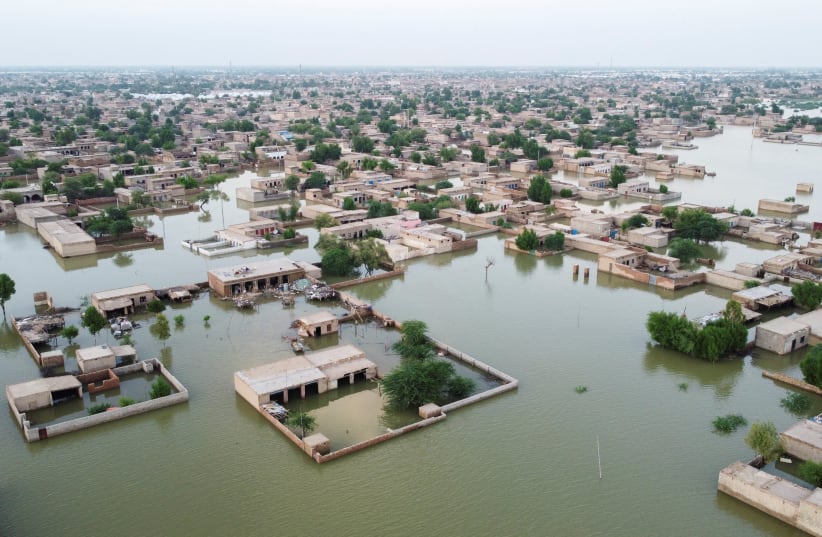As a result of the devastating floods in Pakistan, waterborne diseases and famine are feared to be spreading among the masses of flood-affected Pakistanis.
Flood waters have submerged approximately one-third of the country, washed away crops and destroyed more than 1.7 million homes, infrastructure and thousands of miles of roads and railway tracks and bridges.
The United Nations latest data show that close to 8 million people have been displaced by the disaster; meanwhile, according to official figures, some 1,600 people – including 552 children – have lost their lives so far.
“The waterborne diseases and famine are threatening to be more deadly than the initial deluge,” UN officials warned on Wednesday.
According to a United Nations International Children's Emergency Fund (UNICEF) report: “Millions of children and pregnant women are at risk in flood-affected areas.”
The UNICEF report said that “displaced families sleep in tents or in the open within a few meters of large pools of stagnant water, while daytime temperatures exceed 40 degrees Celsius.”
The UNICEF report also stated: “More than 3 million children are in need of humanitarian assistance and are at increased risk of waterborne diseases, drowning and malnutrition due to the most severe flooding in Pakistan.”
The report additionally said that the immediate needs of people affected by the floods include “shelter, clean drinking water, food, sanitation facilities, medicines and medical supplies, nutritional support to mothers and children, hygiene support and bed nets.”
“The waterborne diseases and famine are threatening to be more deadly than the initial deluge.”
UN officials
Agricultural damage
The floods have seriously harmed Pakistan’s agricultural sector as well, damaging food security in the country.
Agricultural land swamped by flooding also will have a long-term humanitarian and economic impact on the country. Billions of dollars’ worth of rice, sugar, and wheat have already been lost, and Pakistan has had to import tomatoes and onions from neighboring Afghanistan and Iran.
More than 500 health facilities were damaged in Sindh province alone; meanwhile, 240 health facilities were damaged in the affected districts in Balochistan province.
UNICEF is working with government and non-governmental partners to respond to the urgent needs of children and families in affected areas.
Abdul Sami Malik, a communication specialist for UNICEF Pakistan, told The Media Line that, in such emergencies, “children are the most vulnerable and are in dire need of psychosocial support and recreation to reduce the effects of flood trauma.”
“The floods are undermining the resilience and psychosocial well-being of children and their caregivers, leaving many experiencing distress with limited or strained support systems,” Malik added.
In a United Nations rapid needs assessment conducted in Balochistan province, 43% of girls, 45% of boys and 55% of caregivers were reported to be showing signs of stress, Malik told The Media Line.
He also said that, according to the latest available data, 23,900 schools were damaged or destroyed in the recent floods, with more than 5,000 school buildings still being used as relief camps.
“We are providing clean drinking water and sanitation facilities by installing pit latrines, scanning mothers and children to check their nutritional status, and providing supplements in case of malnutrition,” Malik said.
“UNICEF is also supporting immunization services for mothers and children to ensure that there is no break in routine immunization processes,” he said.
An overall funding appeal of $160 million has been undertaken by the government of Pakistan and the United Nations. UNICEF’s part of the appeal is $39.16 million, according to Malik, and only about one-third of it has been received. And this number is likely to be revised over the next few days as the true extent of the disaster continues to unfold.
“Without more immediate support, UNICEF cannot respond to the sheer scale of the destruction and children’s lives will be lost,” he said.
Waterborne disease
UN humanitarian coordinator for Pakistan, Julien Harneis, said Pakistan is facing a cascading “second disaster” from diseases such as dengue, malaria, cholera and diarrhea, as well as malnutrition.
“My personal concern is that mortality from the waterborne diseases and from malnutrition will be higher than what we’ve seen so far,” he told a press conference last week in the capital, Islamabad.
Sind is the most flood-affected province in Pakistan.
Dr. Azra Pechuho, the provincial health minister, told The Media Line: “Sindh (provincial) government has set up 4,210 medical camps in the affected areas so that the victims of waterborne diseases and skin diseases can be treated immediately.” She added that “health officials have also identified widespread trauma problems following the floods.”
“We have especially deployed emergency medical teams, which are carrying out the duties of providing medicines and clean drinking water to the flood victims living in tents and makeshift camps,” she said.
Dr. Natalia Kanem, executive director of the United Nations Population Fund (UNFPA) said in a recent statement: “Of the 33 million people affected, 6.4 million need immediate humanitarian assistance, including more than 1.6 million women of reproductive age. An estimated 128,000 of these women are pregnant, with 42,000 births expected in the next three months.”
“Women and girls bear the brunt of the devastating impacts of climate change and the rising prevalence of natural disasters. When crisis hits, women do not stop getting pregnant and giving birth, and the risk of violence escalates rapidly,” she added.
Kanem further said that “UNFPA is urgently providing hospital tents, reproductive health kits and life-saving supplies to the affected areas so that vital health services can continue.”
The damage caused by the recent flooding is “multi-dimensional,” according to Malik, and “should thus be assessed in the background of the commutative effects of pervasive geopolitical instability, a sense of national insecurity and rising poverty underpinned by human misery and consequent psychosocial toxicity.”
Malik further told The Media Line: “People and their belongings have been swept away. Those fortunate to be alive have sustained physical injuries and invariably all are severely mentally traumatized.”
He noted that “displaced people are living in highly unhygienic conditions; gastroenteritis, hepatitis, malaria, snake bites and a host of serious medical conditions will take a toll if urgent help is not provided.”
PTSD from floods
Malik points out that children will be the worst affected. “Those who survive would invariably suffer from serious mental conditions; trauma of this proportion can damage the hippocampus in the brain and prime the fragile limbic system to a life of misery. Conditions like post-traumatic stress disorder, anxiety, depression, conduct disorders and drug dependence can cause serve morbidity, dysfunction and even mortality.”
He added that, if not treated, “the emotional suffering of these children and their families would be phenomenal, while the financial cost to the community could paralyze the economy of the entire country.”
In addition, he said, “mental disorders and concomitant psychosocial toxicity is likely to produce mass dehumanization in the communities, promoting fanaticism, fundamentalism and fatalistic behaviors posing threat to the governance of the country and beyond.”
Malik stressed that “the scale of this disaster is such that Pakistan will not be able to manage without realistic support from the world communities.”
Tanzeela Javed, a Rawalpindi-based psychologist, told The Media Line that such disasters upset the lives of people living in affected areas for a long time after the event.
“The most commonly diagnosed psychiatric illness among people living in flood-affected areas is post-traumatic stress disorder (PTSD), which manifests as sleep problems, emotional distress, avoidance and emotional disturbances,” she said.
“Some people may also experience a temporary or permanent loss of employment. For children, attending temporary school may result in being separated from parents, which disturbs them mentally in such a terrible situation,” Javed said.
"There is an urgent need for a coordinated strategy to deal with this critical situation," she added. “Farms will be resettled and life will once again flow on its way, but if the psychological condition of such children is not treated in time, they may cause irreparable damage not only to their families but also to society.”
Yaseen Ayaz, a researcher based in Quetta, the provincial capital of Balochistan, and a public policy graduate of the Pakistan Institute of Development Economics (PIDE), told The Media Line: “Waterborne diseases are common in the flood-affected areas and, according to health officials, at least 324 people have died due to waterborne diseases.”
Ayaz noted that “as flood waters begin to recede, Balochistan, Sindh and southern Punjab – flood-affected districts – will be more prone to the diseases such as malaria, dengue, fever, diarrhea and skin problems.”
Meanwhile, Pakistan’s “weak and outdated health system” is not able to cope with these emerging health challenges, according to Ayaz. “So, in these circumstances, it is better to fight the situation together with international organizations,” he said.

